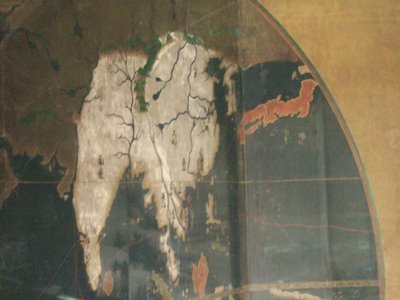Sunday, July 16, 2006
Japanese origin 4
Yayoi period middle.(B.C.100~A.D.100)
The use of the ironware was popularized rapidly. Iron was used for utilities such as a farm implement, a tool and a weapon. All the iron raw material was imported from the Korean Peninsula. Then, finished goods were made in Japan. But, a stone implement should notice that it used at the same time, too. Probably, ironware was valuable articles, and many people might not have been able to have it. The people who had ironware reclaimed land easily. Then, they might have owned much agricultural land. An agricultural production rose greatly. The difference in rich and poor was formed, and then the difference in social position was formed as that result. And, quarrels over the land and the wealth increased, too. They dig a moat around the village. This is known as Kango-Syuraku. Or, they built a village on the hill. These aimed at the defense. Then, they looked for a strong weapon, too.
I was surprised at the fact that Korea traded with Japan in this age. Did they have high navigation and the technology of the shipbuilding? What did a Japanese exchange for the iron?
The use of the ironware was popularized rapidly. Iron was used for utilities such as a farm implement, a tool and a weapon. All the iron raw material was imported from the Korean Peninsula. Then, finished goods were made in Japan. But, a stone implement should notice that it used at the same time, too. Probably, ironware was valuable articles, and many people might not have been able to have it. The people who had ironware reclaimed land easily. Then, they might have owned much agricultural land. An agricultural production rose greatly. The difference in rich and poor was formed, and then the difference in social position was formed as that result. And, quarrels over the land and the wealth increased, too. They dig a moat around the village. This is known as Kango-Syuraku. Or, they built a village on the hill. These aimed at the defense. Then, they looked for a strong weapon, too.
I was surprised at the fact that Korea traded with Japan in this age. Did they have high navigation and the technology of the shipbuilding? What did a Japanese exchange for the iron?
Saturday, July 15, 2006
The Yayoi Period
About the third century from about the fourth century B.C. is called Yayoi period. Quantities of people came over to northern Kyushu Japan from the Chinese and the Korean Peninsula. They introduced rice farming and the tool of the metal. Then, rice farming began in earnest in Japan. Efficiency improved by the iron tool greatly. Then, harvests increased. This meaning is very big. Population increased by securing food steadily. Then, the scale of the village grew big. The difference in rich and poor was formed by the accumulation of the agricultural produce becoming possible.Then, it proceeded to the difference in social position. The Yayoi Period was the age when hierarchical society (earlier socity) was formed.
I have one doubt. Why did they come over to Japan? They had the tool of the iron which was the latest technology. They might have thought about Japan with the remote place and uncivilized tribes were. Japan might not have been attractive for them. There is one opinion. It is said that they were political refugee. It was desperate, and they came over to Japan.They avoided a collision with the Jomon-jin who is a native people. Then, they chose the method of the coexistence and the fusion. I think this thought to be right. Many people came over to Japan after that until about the seventh century. In the beginning, they might have unavoidably come over to japan as a refugee. China and Korea intended to be the homes which couldn't be forgotten for them. Then, it might have been the ground of admiration. They might have hoped to come back to home strongly. They harmonized with the Jomon-jin, and lived in Japan. Then, they might have told a descendant. As for China and the Korea, as for being a wonderful country, and as for civilization. It was decided that the Korean Peninsula and Japan have very good connection. I think that it is because there was their strong homesickness.
Thursday, July 13, 2006
Japanese origin 2
The Jomon period.
The Jomon period began about 12000 years ago. That age lasted until about B.C. the second century. It is the age when an earthenware begins to be used. The Japanese archipelago were one of the areas where an earthenware was invented in the world first. As for food, it became possible by the earthenware that a food was boiled. They got more food materials by cooking it. A fireplace is being used in the old house of Japan. That is called Irori. The people cook the food materials with the pot hung from the ceiling. A tool to hang from the ceiling is called Jizaikagi. It feels to inherit the structure of the residence in the Jomon period. It is the rational structure that it can be cooked with indoor heating.
A Jyomon-jin lived in the group of the relationship in the Jomon period. That number was about thirty people from twenty people. They lived by the hunting and fishing. And, it was the life which depended on picking such as a nut. It seems that cereals cultivation by slash and burn agriculture and rice farming were being done in a part, too. But, it thinks that efficiency was very bad with a stone implement. Their life depended on the blessing of the nature. Therefore, they were fearful for the nature. Therefore, they worshiped all which existed in the nature. Then, they believed that a soul resided in all which existed in the nature. Such faith is said as natu-ism (nature worship) and the animism. As for the present day as well, natural worship and animism give Japanese faith a great influence. A Japanese has the first visit to the shrine in the New Year. And, the funeral is held in the Buddhist rites. The wedding is held in the church and a Christmas is celebrated, too. A Japanese accepts various God in such cases as Christianity,Taoism, the Zen sect and the Shinto. Polytheism is believed God and a spirit to reside in all which exist in the nature. Therefore, a Japanese accepts various God in the unconsciousness. The animism of the Jomon period exists at the bottom of the modern Japanese heart. They are a stone, a river, a mountain, trees, thunder, rain and illness, the thought that a spirit exists in every phenomenon. God of 8000000 appears for the Japanese myth. This takes the influence of natural worship and the animism strongly, too. Both Christ and Buddha, Allah may be included in God of 8000000 for the Japanese. This is very important when we think about Japanese religion and faith.
Saturday, July 08, 2006
Japanese origin 1

Proto-Japanese
Where did a Japanese ancestor come from? How does a Japanese think about religion? Who was Japanese origin? I want to try to think about this fundamental question.
It is said that mankind's origin is in Africa about 6000000 years ago. A part of them moved east. Then, they reached Southeast Asia at last. It can think that a part of them reached Japan at last, too. They are called Old Mon-gol-oid. The cenozoic Quaternary, it was about 10000 years ago. The Japanese archipelago separated from the old continent completely. Then, present the Japanese archipelago were formed. There is mankind who lived in the Japanese archipelago at that time. It can think that they are the direct ancestors of Japanese. They are called the Jyomon-jin(the person of the Jomon period).
On the other hand, there was mankind who moved to the north of the Himalayas. They moved from the Siberia to China and the Korea. Then, some of mankind reached Japan. They are called New Mongoloid. They come to have the physical characteristics to adapt to the coldness. Body hair is very thin. An eyelid is single edged. A face is depressed. A nose is short. These are because it doesn't suffer from frostbite. Some New Mongoloid who settled in the Korean was very much came over to Japan. They were very much came over to Japan from about B.C. the fourth century to about the seventh century. The jyomon-jin is old Mongoloid. And New Mongoloid who settled in the Korean. They repeated mixed parentage for more than 1000 years. They are Japanese ancestors. This is said as the Proto-Japanese.
